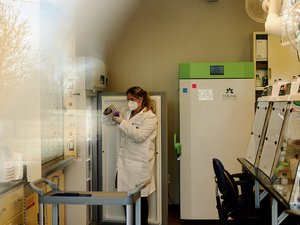
Ohio State University beats the national average for early-stage activity that can lead to spinoff companies and products, but still awaits the payoff – lagging national peers in the income it generates from technology commercialization, according to the latest survey by the trade group AUTM.
Only two other Big Ten schools had less commercialization income in FY21; Ohio State had been in the middle of the pack for several years, according to ongoing Columbus Inno and Columbus Business First research.
The university's revenue from licensing deals and spinoffs based on faculty, staff and student discoveries slipped to $3.2 million in fiscal 2021 – the year Ohio State surpassed $1 billion in research spending for the first time. The school last week reported that research expenditures hit a new high of $1.4 billion in fiscal 2022.
Income had been $5.7 million in 2020 and peaked at a record $8.9 million in 2019 after one-time payments from acquired spinoffs. Median revenue was $14.5 million in 2021 among 56 universities and hospitals with more than $470 million in annual research spending, according to AUTM's annual Licensing Activity Survey.
But Ohio State had 305 new invention disclosures in the year, which starts the commercialization process, and 14 startups formed, above national averages.
Rutgers was the new Big Ten champ for 2021, with $47 million in gross income. Commercialization revenue includes royalties, sales of equity stakes in startups and other forms.
Far and away the largest earner in the year – and demonstrating the dramatic global impact of research – was Penn, with $310 million in licensing income. The private university's patented mRNA technology was the core of both the Moderna and Pfizer-BioNTech Covid-19 vaccines.
Overall, research spending per institution increased over 2020, but fewer universities, hospitals and other institutions participated in the AUTM survey, so the total declined.
“You could see 2021 was a challenging year,” AUTM CEO Stephen Susalka said. “It was a hangover from the pandemic.”
However, the number of licenses and options executed did increase nationwide, which could lead to future revenue.
“That’s a nice leading indicator for downstream products,” he said in an interview. The organization is collecting data now for the FY22 survey.
"Innovation is stochastic – you don’t quite know where it’s going to show up," Susalka said. "Not every startup company is going to turn into the next ginormous company. The hope is they do. It’s a process of de-risking that technology."
U.S. institutions executed more than 10,000 licenses and options, launched nearly 800 products and spun out nearly 1,000 startups, according to AUTM's summary. There are more than 6,000 still-operating companies spun out of research institutions nationwide.
"No statistic jumped out at us more than staffing: Between FY20 and FY21, licensing staff ranks were depleted by almost 12%," the AUTM report said.
Ohio State definitely bucked that trend: The Technology Commercialization Office grew to 13.5 full-time equivalent licensing officers in 2021 from nine, after shrinking over the years from 15 in 2015, the school told Columbus Inno last year when reporting its individual numbers. Data in the nationwide survey lag by a year.
Ohio State has renewed emphasis on ensuring its research turns into products and services impacting real life. It's building a more than $1 billion Innovation District on west campus, hosting partners such as Nationwide Children's Hospital, the state's tech commercialization leader.
"It is a wonderful way to increase the number of creative collaborative collisions," Susalka said. "That’s one of the benefits of localized places.
However, the university is losing both champions of the effort who had devoted more resources to commercialization and united the research office with licensing and industry outreach. President Kristina Johnson is leaving at the end of the academic year, and Grace Wang, executive vice president for research, innovation and knowledge enterprise, was named president of Worcester Polytechnic Institute.
University trustees have long pushed to improve commercialization. The chairman of the committee overseeing research and innovation is Lou Von Thaer, CEO of Columbus research giant Battelle, which has amped up its own efforts to spin out successful companies.
"(Under Johnson and Wang), we've gotten investments like we’ve never had before, to get the staff we need to really operate with excellence," Kevin Taylor, associate vice president of technology commercialization, said a year ago when reporting the FY21 numbers.







